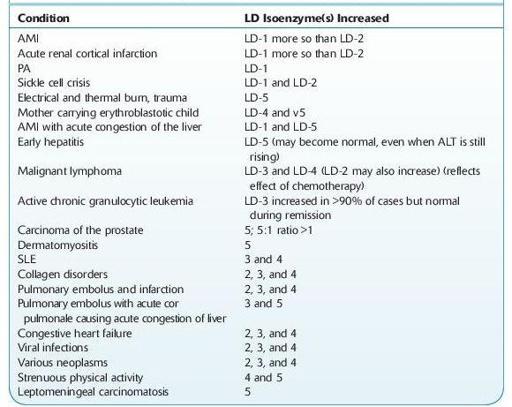Wallach's Interpretation of Diagnostic Tests: Pathways to Arriving at a Clinical Diagnosis (1044 page)
Authors: Mary A. Williamson Mt(ascp) Phd,L. Michael Snyder Md

BOOK: Wallach's Interpretation of Diagnostic Tests: Pathways to Arriving at a Clinical Diagnosis
9.05Mb size Format: txt, pdf, ePub

Limitations
A hemolyzed specimen is not acceptable as RBCs contain much more LD than serum. Causes can include transportation via pneumatic tube, vigorous mixing, or traumatic venipuncture. Tubes should be void of air bubbles to prevent minor hemolysis.
LD activity is one of the most sensitive indicators of in vitro hemolysis.
Hemolysis causes anomalous elevation of LD-1 such that any ex vivo hemolysis must be strictly avoided.
Freezing or prolonged storage at 4°C (>12 hours) causes LD-5 to be lost.
Elevations of intermediate forms (LD-2–LD-4) of LD are rarely used to define a tissue of origin, and such reports are largely anecdotal.
Although increases in serum LD also are seen following an MI, the test has been replaced by the determination of troponins.
LACTATE, BLOOD
Definition
Blood lactate, also known as 2-hydroxypropanoic acid, lactic acid, or
L
-lactate, is an end product of anaerobic glycolysis as an alternative to pyruvate entering the Krebs cycle, enabling metabolism of glucose. Major sites of production are skeletal muscle, brain, and erythrocytes. Lactate is metabolized by the liver.

Normal range:
0.3–2.4 mmol/L.

Critical value:
>5 mmol/L.
Use
Other books
King of the Castle by Victoria Holt
The Spectacular Now by Tharp, Tim
Vicarious (The Vicarious Trilogy) by Annin, Sina
The Chinese Takeout by Judith Cutler
Do No Harm: Stories of Life, Death and Brain Surgery by Henry Marsh
A Lick of Flame by Cathryn Fox
Jade Lee by Winning a Bride
Skin by Patricia Rosemoor
Francesca's Party by Patricia Scanlan
Brown, Dale - Independent 01 by Silver Tower (v1.1)
